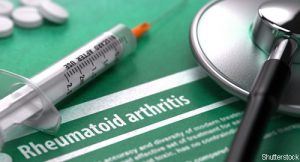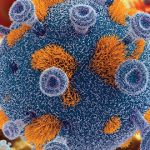 ATLANTA—A key goal for rheumatology researchers and clinicians is to predict through specific biomarkers if someone will, at some point in their future, develop rheumatoid arthritis (RA). If so, the disease could be prevented or stopped before the inflammation and ravaging begins, explained researchers during a Basic Science lecture at the 2019 ACR/ARP Annual Meeting titled Tipping the Balance from Preclinical Autoimmunity to Overt RA.
ATLANTA—A key goal for rheumatology researchers and clinicians is to predict through specific biomarkers if someone will, at some point in their future, develop rheumatoid arthritis (RA). If so, the disease could be prevented or stopped before the inflammation and ravaging begins, explained researchers during a Basic Science lecture at the 2019 ACR/ARP Annual Meeting titled Tipping the Balance from Preclinical Autoimmunity to Overt RA.
As Georg Schett, MD, from the Department of Medicine at the University Erlangen-Nürnberg, Germany, pointed out, researchers have known for some time that anti-citrullinated protein antibodies (ACPAs) and rheumatoid factors (RFs) in patients appear many years prior to RA onset, and that immunoglobulin A (IgA) RFs also appear in patients years prior to clinical symptoms. “This suggests the body can contain autoimmunity for quite a long time before disease appears,” said Dr. Schett. “So autoimmunity does not mean we get sick. We can live with anti-nuclear antibodies [ANA] for quite a long time without disease.”
The challenge facing researchers is applying this burgeoning knowledge to effective therapies.1
Dr. Schett said some of our immune functions are locked until needed for fighting microbial triggers such as Salmonella, Staphylococcus and measles, when you need an antibody response via effector function. “However, this effector function needs to be controlled, otherwise you would die immediately because you would be inflamed all the time,” Dr. Schett said. “[Unfortunately], it’s not totally clear at this time how this locking of autoimmunity works.”
One concept, explained Dr. Schett, is that infections could be an important second hit for the onset of RA. During infection, he explained, the interleukin (IL) 17, IL-23 response is turned on and antibodies with effector function are activated to fight the bacteria. But at the same time, there is a continuous production of cyclic citrullinated peptides (CCP) and an anti-citrullinated protein antibody (ACPA) response. “This could explain why second-hit infections could trigger the transition from autoimmunity to clinical overt rheumatoid arthritis,” said Dr. Schett.2
Another concept being explored is impaired gastrointestinal (GI) function leading to arthritis onset. In this leaky gut scenario, activated immune cells transition into the joints. Dr. Schett said so far this has only been tested on Kaede mice using photo conversion after ultraviolet light exposure.3 Using a collagen-induced arthritis model, cell movement can be tracked, displaying the photo-converted T cells moving into the spleen and lymph nodes, but predominantly into the joints. Dr. Schett said researchers were able to restore the GI epithelial barrier function by administering larazotide acetate.
Harnessing Effector Functions
Research using this knowledge is underway, said Margie Ackerman, PhD, professor of engineering at the Thayer School of Engineering at Dartmouth College. One aspect under investigation by her lab and others is the regulation of B cell/antibody effector functions for effective host defense.
Dr. Ackerman said it’s commonly known antibodies are the original, multi-specific proteins, linking the adaptive and innate immune systems by recognizing targeted antigens (hopefully intended) and pathogenic target antigens (but not always) with the innate immune arm of the immune system to clear pathogens. “So when antibodies aren’t binding to targets of interest, such as a pathogenic one, they’re doing all sorts of other things,” she said
One factor associated with variable effector function is glycosylation. Dr. Ackerman said, “Glycobiology is complex, it has its own language and it’s a non-templated process.” The complexity does not deter researchers. “We’re working to try and understand the collection of antibody types and how they relate to infectious disease outcomes. … Lots of measurements [are being made] to understand the spectrum of features and epitopes, antigen specificities, subclasses, glycosylation states and requisite functions, and how they relate to whether an individual is protected or experiences pathology.”
Dr. Ackerman has been involved in numerous studies in this area, including many related to HIV vaccines.4 One study she co-authored on non-human primates in 2017 found that an HIV-1 vaccine of recombinant poxvirus (ALVAC) and recombinant HIV-1 gp120 subtype B/subtype E (B/E) proteins demonstrated 31% vaccine efficacy.5
This was followed by a human study led by Scott Neidich, PhD, Duke University, Durham, N.C., on a preventative vaccine efficacy trial testing DNA followed by recombinant adenovirus serotype 5 (rAd5) in men.6 “An efficacious vaccine that provides durable immunity remains a key priority in the fight against HIV-1,” the researchers wrote.
Their goal, similar to Dr. Ackerman’s earlier research, was to test whether vaccine-elicited antibodies can recruit and activate innate immune effector cells. It did. “Data support a role for vaccine-elicited anti-HIV-1 Env IgG3, antibody engagement of Fc receptors and phagocytosis as potential mechanisms for HIV-1 prevention, ” the authors concluded.
Dr. Ackerman said these correlates hold predictive power for other vaccines and other immunization studies. “Antibody effector functions, binding to FcR and IgG glycosylation profiles can be key aspects of the humoral response, and are distinct from response magnitude,” she said.
“This opens up a lot of new doors,” Dr. Ackerman said. “We’re thinking of deploying these tools to other settings and binding them with how well the intersection of top-down and bottom-up data-rich studies fuel new basic insights that change our understanding of antibody-mediated protection and pathology in the next decade.”
Anti-Modified Protein Antibodies in Pre-RA
Rene Toes, PhD, is director of experimental rheumatology in the rheumatology department at Leiden University Medical Center, The Netherlands. A large part of his research focuses on chronic immune stimulation, the breach of tolerance and the evolution of human auto-reactive B cell responses, as well as the role of auto-antibodies and auto-reactive B cells in rheumatic diseases.
Dr. Toes, who has authored more than 350 publications on rheumatic diseases, said the extensive glycosylation of the ACPA-IgG variable domain is estimated to be present on more than 90% of ACPA molecules in RA and found in different RA populations, and that it precedes the development of RA. “They can be present years before disease onset, and [they] rise closer to disease onset. They might provide a predictive marker for disease development in ACPA-positive subjects at risk because progression to RA is unlikely in the absence of ACPA V-domain glycans.” Variable domain glycans (V domain) are located in proximity to the antigen binding pocket and interact with antigen-binding pockets.7-9
ACPAs differ from most other antibodies because they are extensively glycosylated in the V-domain. “This is a result of the introduction of N-linked glycosylation sites by somatic hyper mutation,” Dr. Toes said.10
Dr. Toes added that the glycans do not affect antigen-specificity or avidity for antigen-binding, but do provide a selective advantage to ACPA-expressing B cells. Because V domain glycans are introduced before disease onset, “their presence might provide a predictive marker for disease development in ACPA-positive subjects at risk.”11
Mike Fillon is a healthcare writer living in the Atlanta area.
References
- Nielen MM, van Schaardenburg D, Reesink HW et al. Specific autoantibodies precede the symptoms of rheumatoid arthritis: A study of serial measurements in blood donors. Arthritis Rheum. 2004 Feb;50(2):380–386.
- Pfeifle R, Rothe T, Ipseiz N. Regulation of autoantibody activity by the IL-23-TH17 axis determines the onset of autoimmune disease. Nat Immunol. 2017 Jan;18(1):104–113.
- Taneja V. Arthritis susceptibility and the gut microbiome. FEBS Lett. 2014 Nov 17;588(22):4244–4249.
- Ackerman ME, Das J, Pittala S, et al. Route of immunization defines multiple mechanisms of vaccine-mediated protection against SIV. Nat Med. 2018 Oct;24(10):1590–1598.
- Bradley T, Pollara J, Santra S, et al. Pentavalent HIV-1 vaccine protects against simian-human immunodeficiency virus challenge. Nat Commun. 2017 Jun;8(8):15711.
- Neidich SD, Fong Y, Li SS, et al. Antibody Fc effector functions and IgG3 associate with decreased HIV-1 risk. J Clin Invest. 2019 Nov 1;129(11):4838–4849.
- Kissel T, van Schie KA, Hafkenscheid L, et al. On the presence of HLA-SE alleles and ACPA-IgG variable domain glycosylation in the phase preceding the development of rheumatoid arthritis. Ann Rheum Dis. 2019 Dec;78(12):1616–1620.
- Kampstra A, Dekkers JS, Volkov M, et al. Different classes of anti-modified protein antibodies are induced on exposure to antigens expressing only one type of modification. Ann Rheum Dis. 2019 Jul;78(7):908–916.
- Vergroesen R, Slot L, Hafkenscheid L, et al. B-cell receptor sequencing of anti-citrullinated protein antibody (ACPA) IgG-expressing B cells indicates a selective advantage for the introduction of N-glycosylation sites during somatic hypermutation. Ann Rheum Dis. 2018 Jun;77(6):956–958.
- Scherer HU, Huizinga TW, Krönke G, et al. The B cell response to citrullinated antigens in the development of rheumatoid arthritis. Nat Rev Rheumatol. 2018 Mar;14(3):157–169.
- Hafkenscheid L, de Moel E, Smolik I, et al. N-linked glycans in the variable domain of IgG anti-citrullinated protein antibodies predict the development of rheumatoid arthritis. Arthritis Rheumatol. 2019 Oct;71(10):1626–1633.



